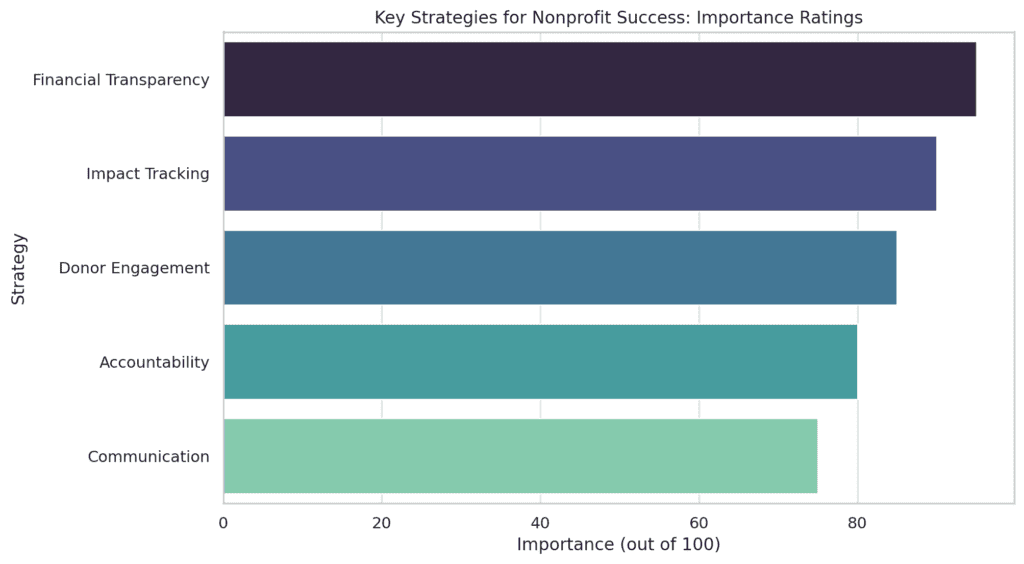How Donation Transparency Drives Mission Success
Key Takeaways
| Aspect | Details |
|---|---|
| Transparency Importance | Critical for building donor trust and driving mission success. |
| Donation Tracking | Essential for demonstrating how funds are utilized effectively. |
| Myths about Donations | Dispelling common misconceptions to enhance understanding. |
| Nonprofit Accountability | The key to strengthening donor relationships and ensuring sustainability. |
| History of Donation Transparency | Exploring the evolution and its impact on current practices. |
| Strengthening Donor Trust | Strategies to cultivate a strong, loyal donor base. |
The Evolution of Donation Transparency
The concept of donation transparency has evolved significantly over the years. To fully appreciate its current impact, it’s essential to understand its history. Explore the history of donation transparency to gain insights into how past practices have shaped today’s standards and expectations.
Dispelling Myths about Donations
Misconceptions about nonprofit operations can hinder the success of charitable organizations. Dispelling these myths is crucial for a transparent relationship between nonprofits and donors. Learn about common donation myths and how transparency can address these misconceptions effectively.
Building Nonprofit Accountability
Accountability is a critical component of effective nonprofit management. By embracing transparent practices, organizations can demonstrate their commitment to responsible stewardship of donations. Discover how to build nonprofit accountability to ensure that every dollar donated is making a real difference.
Tracking Donations: The Heart of Nonprofit Transparency
Effective donation tracking is pivotal for any nonprofit aiming to maintain transparency and accountability. By understanding where each donation goes, nonprofits can assure donors their contributions are being used as intended. This not only strengthens donor trust but also enhances the nonprofit’s credibility and effectiveness. Let’s explore how key principles of transparent donations guide this process.
Why Nonprofits Need to Track Donations
- Efficient Fund Allocation: Proper tracking enables nonprofits to monitor and strategize fund allocation for maximum impact.
- Simplified Reporting: Comprehensive tracking systems ease the process of generating detailed reports for stakeholders and regulatory bodies.
- Enhanced Donor Management: Maintaining accurate records of donor activities aids in building stronger, more personalized relationships.
- Data-Driven Decision Making: Analyzing donation data helps nonprofits make informed decisions and improve their strategies.
Challenges in Implementing Donation Tracking Systems
Despite the benefits, nonprofits often face challenges in implementing these systems, such as:
- Financial Constraints: Limited budgets can hinder the adoption of advanced tracking technologies.
- Staff Training and Adaptation: Employees may need training and time to adjust to new digital tools.
- Data Security: Ensuring the protection of sensitive donor information is a significant concern.
Overcoming Implementation Challenges
To overcome these obstacles, nonprofits can adopt best practices like:
- Choosing Cost-Effective Solutions: Opting for scalable and affordable tracking systems.
- Investing in Staff Training: Providing comprehensive training and support for seamless adaptation.
- Prioritizing Data Security: Implementing robust security measures to protect donor information.
The Role of Technology in Donation Transparency
The use of technology in donation tracking has revolutionized how nonprofits manage and report their finances. Digital tools offer real-time tracking capabilities, streamline processes, and enhance data accuracy. Technologies like Givelify not only simplify the tracking process but also ensure the safety and privacy of donor information.
Technology-Driven Advantages
- Real-Time Information Access: Digital platforms provide immediate access to donation data, enabling quicker response and strategy adjustments.
- Reduced Human Error: Automation minimizes mistakes that can occur with manual data entry.
- Data Analytics for Strategic Planning: Analyzing donation patterns and trends to optimize fundraising efforts.
Effective Use of Digital Platforms
Nonprofits can maximize the benefits of technology by:
- Integrating Software Systems: Using platforms that combine multiple functionalities for a streamlined process.
- Leveraging Data for Better Engagement: Utilizing analytics to understand donor behaviors and preferences.
External Perspective on Donation Transparency
For an external perspective on the importance of donation transparency, nonprofits can refer to sources like Neon One, which offers insights and solutions for fund tracking and donor management.
Engaging Donors through Technology
Nonprofits can enhance donor engagement by:
- Personalizing Communication: Using data to tailor messages and appeals to individual donors.
- Providing Transparent Reporting: Offering clear and detailed reports on how donations are being used.
Strengthening Donor Trust Through Transparency
Transparency is not just about showing how funds are used; it’s about building a relationship based on trust and honesty. Nonprofits can strengthen this trust by:
- Being Open about Challenges: Sharing not only successes but also the difficulties faced and lessons learned.
- Regularly Updating Donors: Keeping donors informed about ongoing projects and their impact.
Enhancing Donor Engagement: The Path to Building Trust
Engaging donors effectively is a critical component of maintaining transparency and trust. It involves not only showing how donations are used but also creating a sense of belonging and value for donors. Here are some key strategies to enhance donor engagement:
Personalized Donor Communications
- Personal Thank You Messages: Sending personalized thank-you messages after each donation is a simple yet powerful way to express gratitude and connect with donors on a personal level.
- Donor Appreciation Events: Hosting events, whether in person or virtually, provides an opportunity to celebrate donors, gather feedback, and strengthen community ties.
- Multi-Channel Communication: Using a variety of platforms, such as emails, letters, social media, and videos, helps keep donors informed and engaged.
Innovative Engagement Strategies
- Text Messaging: Leveraging text messaging for updates and reminders can enhance engagement, especially given the high open rates of text messages.
- Peer-to-Peer Campaigns: Encouraging supporters to fundraise on your behalf extends your reach and deepens connections with core supporters.
- Donor Management Software: Utilizing CRM platforms for effective data management and personalized engagement strategies.
Cultivating a Culture of Philanthropy
Creating a culture of philanthropy within the organization is essential for fostering donor trust and loyalty. This involves ensuring that every team member understands the importance of building personal connections with donors and reflects the organization’s values in every interaction.
Transparency and Accountability
- Donor Bill of Rights: Adhering to ethical fundraising practices and making donors aware of your commitment can build confidence in your organization.
- Regular Updates on Impact: Sharing the outcomes and impact of donations transparently helps donors see the tangible results of their contributions.
- Openness to Feedback: Actively seeking and responding to donor feedback demonstrates a commitment to continuous improvement and respect for donor opinions.
Overcoming Common Challenges in Donor Engagement
Nonprofits often face challenges in effectively engaging donors. Here are some ways to address these challenges:
- Understanding Donor Preferences: Knowing how donors want to be involved and tailoring engagement accordingly is crucial for maintaining a positive relationship.
- Embracing Technology: Adopting digital tools and analytics can help in understanding donor behaviors and preferences, leading to more effective engagement strategies.
- Balancing Digital and Traditional Communications: While digital methods are increasingly popular, traditional communication methods like direct mail and phone calls remain important for certain donor segments.
Conclusion: The Power of Trust in Philanthropy

Trust is the foundation of any successful donor-nonprofit relationship. By implementing effective donor engagement strategies, maintaining transparency, and cultivating a culture of philanthropy, nonprofits can strengthen donor trust and drive mission success. Remember, every interaction with a donor is an opportunity to reinforce trust and demonstrate the value of their contribution.
Building Nonprofit Accountability and Impact Tracking
Nonprofit organizations must ensure that every dollar donated contributes to their mission. Establishing clear accountability and effectively tracking the impact of donations are key to maintaining donor trust and proving mission success.
Nonprofit Accountability: A Trustworthy Approach
- Real-Time Donation Transparency: Showcasing how funds are used in real time, as seen on Donation Transparency Trust, provides donors with immediate proof of impact.
- Impact Tracking Systems: Utilizing systems that allow nonprofits to track the direct impact of donations on the ground, similar to Nonprofit Impact Tracking, instills confidence in donors.
- Regular and Detailed Reporting: Frequent and detailed reporting of financial and project outcomes helps in building a culture of transparency and accountability.
Strengthening Donor Trust through Clear Communication
- Open Dialogue: Maintaining an open line of communication with donors about both successes and challenges is crucial for trust-building.
- Personalized Updates: Providing donors with personalized updates about how their contributions are making a difference, as suggested in strategies to Strengthen Donor Trust, reinforces the value of their support.
FAQ: Enhancing Donation Transparency and Trust
How can nonprofits demonstrate their financial transparency to donors?
Nonprofits can showcase their financial transparency by publishing detailed financial statements, including audit reports, and explaining how funds are allocated and utilized towards their mission.
What role does technology play in donation transparency?
Technology, such as real-time tracking systems and donor management software, plays a pivotal role in enhancing transparency by providing accurate and up-to-date information about donation usage and impact.
How can a nonprofit effectively communicate its impact to donors?
Nonprofits can effectively communicate their impact through regular reports, newsletters, and personalized updates that highlight the tangible outcomes of their projects and how these align with the organization’s mission.
What strategies can nonprofits use to strengthen donor trust?
Nonprofits can strengthen donor trust by maintaining open and honest communication, engaging donors through personalized experiences, and consistently demonstrating the impact of their donations.
Final Thoughts: Driving Mission Success through Transparency and Trust
The journey from “dollars to change” is paved with transparency and trust. By adopting robust practices in donation transparency, impact tracking, and donor engagement, nonprofits not only cultivate donor loyalty but also drive mission success. Embracing these principles ensures that every contribution not only counts but also makes a meaningful difference.










